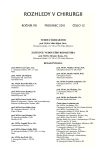IGF1 and Tumor Markers in Different Breast Cancer Stages
Authors:
M. Černá 1; A. Ňaršanská 1; V. Třeška 1; R. Kučera 2; O. Topolčan 2
Authors place of work:
Chirurgická klinika LF UK a FN v Plzni, přednosta: prof. MUDr. Vladislav Třeška, CSc.
1; Centrální izotopová laboratoř LF UK a FN v Plzni, přednosta: prof. MUDr. Ondřej Topolčan
2
Published in the journal:
Rozhl. Chir., 2011, roč. 90, č. 12, s. 688-694.
Category:
Monotematický speciál - Původní práce
Summary
Introduction:
In our work we asked ourselves whether it would be possible to use growth factors for a quick orientation in the clinical status of patients prior to biopsy and histological examination.
Material and methods:
Our patient group included 82 patients with breast cancer. Serum samples were collected preoperatively. Histological examination findings were available for each patient. Our set was divided into three groups based on the disease stage. The values of analytes in different tumor stages were statistically evaluated and statistical comparisons of Stage I and II, and then of Stage II and III were performed.
Results:
Tumor markers CEA, CA 15-3, TK, TPA-M and MonoTotal correlate with the disease severity. Serum levels of the growth factor IGF1 negatively correlated with the severity of cancer. There was aa statistically significant increase in the EGF growth factor serum levels between Stage I and II. No statistically significant differences between Stage I vs. II and Stage II vs. III were detected when HGF and VEGF growth factor serum levels were assessed.
Conclusion:
The growth factor EGF is one of the candidates to become a tumor growth marker in early disease stages. The IGF1, HGF and VEGF growth factors can not be used for quick and correct orientation in the clinical condition of patients in the early stages of tumor growth.
Key words:
breast carcinoma – tumor markers – growth factors
Zdroje
1. Ferlay, J., Autier, P., Boniol, M., Heanue, M., Colombet, M., Boyle, P. Estimates of the cancer incidence and mortality in Europe in 2006. Ann. Oncol., 2007: 581–592.
2. Vrdoljak, E., Wojtukiewicz, M. Z., Pienkowski, T., Bodoky, G., Berzinec, P., Finek, J., Todorovic, V., Borojevic, N., Croitoru, A. Cancer epidemiology in Central and South Eastern European countries. Croat. Med. J., 2011: 478–487.
3. Nekulová, M., Šimícková, M., Pecen, L., Eben, K., Vermousek, I., Stratil, P., Černoch, M., Lang, B. Early diagnosis of breast cancer dissemination by tumor markers follow-up and method of prediction. Neoplasma, 1994: 113–118.
4. Topolcan, O., Holubec, L., Polivkova, V., Svobodova, S., Pesek, M., Treska, V., Safranek, J., Hajek, T., Bartunek, L., Rousarova, M., Finek, J. Tumor markers in pleuraleffusions. Anticancer Res., 2007: 1921–1924.
5. Valík, D., Zima, T., Topolčan, O. Doporučení České společnosti klinické biochemie (ČSKB ČLS JEP), České onkologické společnosti (ČOS ČLS JEP) a České společnosti nukleární medicíny (ČSNM ČLS JEP) k využití nádorových markerů v klinické praxi. 2008.
6. Topolcan, O., Holubec, L., Polivkova, V., Svobodova, S., Pesek, M., Treska, V., Safranek, J., Hajek, T., Bartunek, L., Rousarova, M., Finek, J. Tumor markers in pleural effusions, Anticancer Res., 2007: 1921–1924.
7. Björklund, B. Tissue polypeptide antigen (TPA): Biology, biochemistry, improved assay methodology, clinical significance in cancer and other conditions, and future outlook. Antibiot Chemother., 1978: 16–31.
8. Debus, E., Moll, R., Franke, W. W., Weber, K., Osborn, M. Immunohistochemical distinction of human carcinomas by cytokeratin typing with monoclonal antibodies. Am. J. Pathol., 1984: 121–130.
9. Dupont, J., LeRoith, D. Insulin and insulin-like growth factor I receptors: similarities and differences in signal transduction. Horm. Res., 2001: 22–26.
10. Peterson, J. E., Kulik, G., Jelinek, T., Reuter, C. W., Shannon, J. A., Weber, M. J. Src phosphorylates the insulin-like growth factor type I receptor on the autophosphorylation sites. Requirement for transformation by src. J. Biol. Chem., 1996: 31562–31571.
11. Samani, A. A., Yakar, S., LeRoith, D., Brodt, P. The role of the IGF system in cancer growth and metastasis: overview and recent insights. Endocr. Rev., 2007: 20–47.
12. Dvořák, B. Epidermal growth factor and necrotizing enterocolitis. Clinics in perinatology, 2004: 183–192.
13. Gallagher, J. T., Lyon, M. Molecular structure of Heparan Sulfate and interactions with growth factors and morphogens. In: Iozzo, M, V. Proteoglycans: structure, biology and molecular interactions. Marcel Dekker Inc. New York, 2000: 27–59.
14. Kemp, L. E., Mulloy, B., Gherardi, E. Signalling by HGF/SF and Met: the role of heparan sulphate co-receptors. Biochem. Soc. Trans., 2006: 414–417.
15. Brown, D. M., Michels, M., Kaiser, P. K., Heier, J. S., Sy, J. P., Ianchulev, T. Ranibizumab versus Verteporfin Photodynamic Therapy for Neovascular Age-Related Macular Degeneration: Two-Year Results of the ANCHOR Study. Ophthalmology, 2009: 57–65.
16. Shah, D. K., Menon, K. M., Cabrera, L. M., Vahratian, A. , Kavoussi, S. K., Lebovic, D. I. Thiazolidinediones decrease vascular endothelial growth factor (VEGF) production by human luteinized granulosa cells in vitro. Fertil. Steril., 2010: 2042–2047.
17. Svobodova, S., Topolcan, O., Holubec, L. Jr., Levy, M., Pecen, L., Svacina, S. Parameters of biological activity in colorectal cancer. Anticancer Res., 2011: 373–378.
18. Jacobs, E. T., Martínez, M. E., Alberts, D. S., Ashbeck, E. L., Gapstur, S. M., Lance, P., Thompson, P. A. Plasma insulin-like growth factor I is inversely associated with colorectal adenoma recurrence: a novel hypothesis. Cancer Epidemiol Biomarkers Prev., 2008: 300–305.
19. Herbst, R. S. Review of epidermal growth factor receptor biology. International Journal of Radiation Oncology, Biology, Physics, 2004: 21–26.
Štítky
Chirurgia všeobecná Ortopédia Urgentná medicínaČlánok vyšiel v časopise
Rozhledy v chirurgii

2011 Číslo 12
- Metamizol jako analgetikum první volby: kdy, pro koho, jak a proč?
- MUDr. Lenka Klimešová: Multiodborová vizita je kľúč k efektívnejšej perioperačnej liečbe chronickej bolesti
- Realita liečby bolesti v paliatívnej starostlivosti v Nemecku
Najčítanejšie v tomto čísle
- Stimulace sakrálního nervu v léčbě fekální inkontinence – první zkušenosti v České republice a hodnocení funkčních výsledků
- Torzia dystopickej sleziny – možnosti riešenia
- IGF1 a nádorové markery ve stadiích nádoru prsu
- Karcinom rekta, totální mezorektální excize. Současné trendy v zobrazování a hodnocení kvality. Workshop za účasti prof. R. J. Healda
